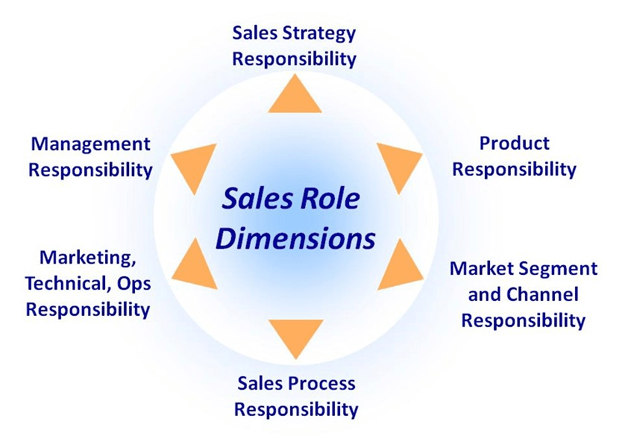The Six Dimensions Of Sales Roles

Defining sales roles has a direct connection to the sales compensation plan.
When identifying the roles, consider these six dimensions. A sales role (channel or job) is comprised of multiple factors that must be considered when structuring and managing a sales team. Use these factors to define sales roles by what you will need to achieve your sales goals – and to design the compensation plan that will motivate each role.

1. Sales Strategy Responsibility. This dimension defines the type of customers the organization is targeting. Is the company retaining current customers? Is it penetrating current customers through either product penetration (selling more of the same products) or buyer penetration (getting additional buyers)? Is it pursuing customer acquisition? This combination of possibilities provides overall direction for the job.
2. Product Responsibility. This dimension describes the products, services, and offers the job will bring to market. Does the rep sell one product, multiple products, or the whole portfolio? The more products individual reps are asked to represent, the more their bandwidth is stretched. A product specialist, for example, should be focused and narrow. A rep selling the whole portfolio may need some overlay specialists for support, especially if it’s a complex offering.
3. Market Segment and Channel Responsibility. For reps working directly with customers, this dimension identifies the groups and characteristics of those customers. Market segments can be defined as simply major accounts, key accounts, middle market accounts, and core accounts; or they may be defined by customers, values, or needs. Market segments may also be described vertically, such as healthcare or transportation, or a combination of these variables.
Channel responsibility refers to coverage and management of third-party channels. An organization may use distributors, resellers, referral partners, or other types of third-party businesses to help get to customers. In that case, it will usually use a role that works with its channel partners. In fact, it may need two roles: a channel acquisition role (someone to go out and acquire those relationships) and a channel management role (someone to manage, cultivate, and develop those relationships).
4. Sales Process Responsibility. This dimension refers to the breadth of the sales process the job will span. The sales process may be expansive, covering lead generation, qualification, solution design, proposal development, deal closing, and even implementation.
If you ask a salesperson to do all of those things – going from lead generation all the way through the close and the implementation – it stretches their bandwidth. That requires a broad set of skills, as compared to having jobs dedicated to lead generation or relying on the marketing team to generate leads. One role may pick up qualified leads, close them, and turn them over to an implementation specialist. Many organizations over-simplify what’s really required in the sales process.
5. Marketing, Technical, and Operations Responsibilities. Some jobs will have dual responsibilities, performing disparate functions. Some jobs are contaminated with other operations roles and have been cobbled together over time. Moving non-selling roles to other functions out of sales can help clean up the sales job and increase its effectiveness.
6. Management Responsibility. This dimension identifies roles the job may have in managing other people in addition to selling. The classic jobs affected by management responsibilities are the selling sales manager and the selling branch manager. These combination roles often appear in organizations with emerging management levels. Having a seller straddle both sales and management is sometimes a first step toward pure management jobs that allows the organization to still attach a unique quota to the job and align its cost with a revenue stream. The reality is that a dual selling and management role can create conflicting priorities. A pure management role, effectively defined and staffed, can provide a much greater revenue impact through leadership and development of multiple sellers.
The big concept concerning sales roles dimensions is that the more functions a job has, the more it gets stretched and the less effective it becomes. As organizations rethink sales with the aim of becoming more effective and having a solid foundation for the compensation program, this customer coverage discipline of job definition is important to understand. Once you decide which roles your organization needs, it’s time to begin compensation plan design.
For more insights and suggestions about sales roles and how to align them with your growth strategy, read What Your CEO Needs to Know About Sales Compensation.
—
This post was updated December 2020.

We Rethink Sales…
SalesGlobe is a data-driven, creative problem-solving firm for sales that solves the most challenging problems.



